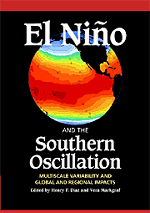Book contents
- Frontmatter
- Contents
- Contributors
- Acknowledgments
- Preface
- SECTION A Global and Regional Characteristics and Impacts of ENSO Variability
- SECTION B Long-Term Changes in ENSO: Historical, Paleoclimatic, and Theoretical Aspects
- 7 The Documented Historical Record of El Niño Events in Peru: An Update of the Quinn Record (Sixteenth through Nineteenth Centuries)
- 8 Tree-Ring Records of Past ENSO Variability and Forcing
- 9 The Tropical Ice Core Record of ENSO
- 10 Long-Term Variability in the El Niño/Southern Oscillation and Associated Teleconnections
- 11 Modulation of ENSO Variability on Decadal and Longer Timescales
- 12 Global Climate Change and El Niño: A Theoretical Framework
- 13 The Past ENSO Record: A Synthesis
- Index
13 - The Past ENSO Record: A Synthesis
from SECTION B - Long-Term Changes in ENSO: Historical, Paleoclimatic, and Theoretical Aspects
Published online by Cambridge University Press: 04 August 2010
- Frontmatter
- Contents
- Contributors
- Acknowledgments
- Preface
- SECTION A Global and Regional Characteristics and Impacts of ENSO Variability
- SECTION B Long-Term Changes in ENSO: Historical, Paleoclimatic, and Theoretical Aspects
- 7 The Documented Historical Record of El Niño Events in Peru: An Update of the Quinn Record (Sixteenth through Nineteenth Centuries)
- 8 Tree-Ring Records of Past ENSO Variability and Forcing
- 9 The Tropical Ice Core Record of ENSO
- 10 Long-Term Variability in the El Niño/Southern Oscillation and Associated Teleconnections
- 11 Modulation of ENSO Variability on Decadal and Longer Timescales
- 12 Global Climate Change and El Niño: A Theoretical Framework
- 13 The Past ENSO Record: A Synthesis
- Index
Summary
Abstract
A broad range of paleoclimate indicators is available to study the El Niño/Southern Oscillation (ENSO) phenomenon. These climate proxy records, each of which is sensitive to somewhat different aspects of climatic variations, can be used for studying ENSO – to answer specific questions, such as, How long has ENSO been operating in its present form? In this chapter, we evaluate the information provided by the various proxy records, highlighting their possible strengths and weaknesses, and pointing out areas where outstanding research questions into the nature of ENSO variability still remain.
At present, the preponderance of evidence suggests that during glacial times, the ENSO phenomenon (if it was operating as an alternating east-west source of heat and moisture to the atmosphere) did not leave the same spatial or temporal expression in the paleoclimate record that is evident more recently. Conditions in the early Holocene, prior to ~6,000 years before present (BP), are indicative of changed atmospheric and oceanic patterns, substantially different from those of today. Only after about 6,000 years ago did the climatic associations related to the changes in sea surface temperature and atmospheric circulation patterns related to ENSO that are seen today begin to be systematically recorded in the paleoclimate record.
Introduction
One of the major expressions of global interannual climate variability is related to the coupled ocean-atmosphere phenomenon of El Niño/Southern Oscillation (ENSO). Because of the far-reaching effects of ENSO on societies, concerns about its future behavior have promoted research into the ENSO phenomenon's long-term history, especially of those intervals when climate boundary conditions (orbitally determined seasonal insolation, global ice cover, sea level, aerosols, etc.) were markedly different from those of today (Diaz and Markgraf 1992).
- Type
- Chapter
- Information
- El Niño and the Southern OscillationMultiscale Variability and Global and Regional Impacts, pp. 463 - 486Publisher: Cambridge University PressPrint publication year: 2000
- 1
- Cited by



